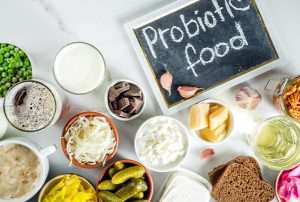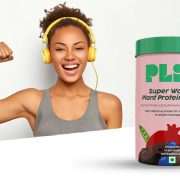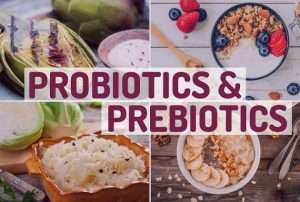Prebiotic and probiotic: Difference, uses, and foods
Pre & Probiotic; What Are They?
People often get jumbled between pre & probiotic chemicals. Many folks are still confused regarding which prebiotics are best for consumption. To put it into simpler terms, prebiotics can be defined as certain chemicals, which are primarily found in plant-based foods, that feed the good bacteria in your stomach. Dietary fibers that act as prebiotics, resistant starches, and polyphenol a class of phytonutrients all encourage the development and activity of microorganisms that are good for your health.
Foods and supplements containing live bacteria that can have various effects on the human body are referred to as probiotics. By preserving the proper level of acidity and preventing opportunistic from colonizing your gut, probiotic bacteria like Lactobacillus and Bifidobacterium help preserve order in the gut microbiome.
Many people have questioned, what is prebiotics and probiotics. How do they work? Both probiotics and prebiotics help the body create and maintain a thriving culture of bacteria and various microbes, which nourishes the gut and facilitates digestion. By giving food to microorganisms and providing a conducive environment for their growth, these food ingredients support the growth of beneficial bacteria. We can’t always track or maintain our probiotic needs in our diet and hence, it’s largely advantageous to consume probiotic supplements instead. Take a look at some benefits of probiotics and prebiotics first!
Benefits Of Probiotics And Prebiotics
1. Prevents Cold And Flu
Probiotics’ natural immune-boosting properties can aid in the prevention of colds and the flu, especially when combined with micronutrients like vitamin E, iron, and selenium. These nutrients work together to increase the synthesis of substances that fight infections, such as antibodies.
2. Bolsters Your Immunity
Everyone needs a strong immune system, and probiotics may help to enhance this system’s performance. According to one study of adults who drank yogurt drinks containing a variety of bacterial strains, probiotics consumption considerably decreased the frequency of upper respiratory infections and flu-like symptoms. Daily probiotic consumption in preschoolers’ diets decreased cold and flu symptoms and the number of sick days lost from school.
3. Helps To Better Your Skin Health
The most prevalent form of eczema in infants and children, atopic dermatitis is characterized by flaky, itchy skin. According to some research, probiotics with Lactobacillus may aid small kids and toddlers with allergies and their symptoms by lowering their likelihood of developing the condition.
4. Known To Improve Your Gastrointestinal Health
Numerous digestive diseases have been proven to benefit from the use of probiotics. They are frequently used in hospital situations to treat both adults and children to lessen diarrhea brought on by taking antibiotics. In addition to helping treat IBS symptoms, several probiotics have been shown to slow the growth of Helicobacter pylori, a stomach colonizing bacteria that has been linked to stomach cancer and ulcers.
5. Reduce The Risk Of Allergies
Probiotics have been shown to decrease and regulate some allergic and inflammatory reactions. A 2015 study found that giving Lactobacillus rhamnosus to children genetically predisposed to eczema lowered their likelihood of developing the condition.
Some other benefits of probiotics and prebiotics are given below here:-
- Help support bowel movement control.
- Release neurotransmitters that stimulate several processes, including mood changes, in your gut and brain.
- Encourage your body to produce hormones that help with hunger, appetite suppression, and other functions.
- Increasing the mineralization and absorption of calcium and phosphorus in your bones can increase bone density.
- Boost the efficiency of your immune system.
- amplify your body’s response to inflammation.
- Boost the growth of healthy bacteria while reducing the creation of disease-causing harmful bacteria.
Difference Between Prebiotics And Probiotics
Prebiotics are discussed less frequently than probiotics, so it’s understandable if you’re a little confused about this. Prebiotics are compounds that are specifically utilized by specific groups of microorganisms for the benefit of the host, but nutritional scientists have maintained the definition broad since research is still adding prebiotic meals to the list.
Here’s how to distinguish between them quickly: Live bacteria, such as those found in yogurt, are probiotics. Prebiotics are dead substances, most frequently dietary fibers, that feed the organisms in your gut already. Some fibers, but not all, can be fermented by gut bacteria. Prebiotic fibers are only regarded as such if bacteria make healthful byproducts while fermenting them.
Some Probiotic And Prebiotic Foods
- Cheese – That cheese platter just became much healthier! Swiss cheese, cheddar, and even Paneer are excellent examples of seasoned cheese that has not been heated. Probiotics are abundant in raw, unpasteurized milk cheese as well.
- Lentils – Lentils or Pink lentils in particular are a fantastic source of good bacteria. This diet not only provides a significant amount of proteins but also aids in managing regular bowel motions.
- Apple – According to research, apples contain 100 million bacteria that can facilitate our gut microbiomes and are therefore more effective than many supplements.
- Oats – Oats are a diverse dietary source that is rich in fiber as well as other nutrients that support a healthy heart and digestive system.
- Dark Chocolate – Probiotics are not found in chocolate, however, it has been discovered that it is an excellent probiotic transporter. To get to the colon, they need chocolate to survive the acidic conditions of the digestive tract. Probiotics could be added to premium dark chocolate because of their preventive properties.
- Garlic – The best way to eat garlic is raw for the best prebiotics. Try not to cook this item if you want to get the prebiotic advantages from it. Sprinkle it onto your salads, dipping sauces, or bread after crushing or mincing it.
FAQs
1. Are there any drawbacks or side effects related to the consumption of probiotics?
A temporary rise in gas, bloating, constipation, and thirst are the most frequent adverse effects. The chemicals in probiotic supplements and the naturally existing amines in probiotic meals can also cause adverse reactions in certain individuals. Stop consuming them if this persists.
2. When should one take these Happy Tummy tablets? Is it okay if I have more than one at a given time?
You can surely take two tablets with a drink. Taking two tablets at once, the benefits of probiotics are doubled, and it is five times as enjoyable and tasty. At your leisure, we recommend having Good Gut twice a day. It is advised to leave a gap of 4-5 hours between each dosage.
3. What is the taste? Is Good Gut free from sugar?
Plix’s Good Gut does not contain any amounts of added sugar and is purely vegan. The flavor of this tablet is like a green apple!
4. How can I tell if my gut is getting better?
When your energy and stamina have been restored, your mental clarity has returned, your mood has improved, you have attained your target weight, and you are starting to feel like your best self, these are some of the biggest indicators that your leaky gut is healing.
5. What might happen if I decide to take probiotics every day? Is it safe?
The added healthy bacteria enables the gut to repopulate and get rid of any remaining toxic germs. As most people think probiotics won’t harm you, they eventually help you feel better a little quicker and can prevent diarrhea. Therefore, they are often added to many diets.















